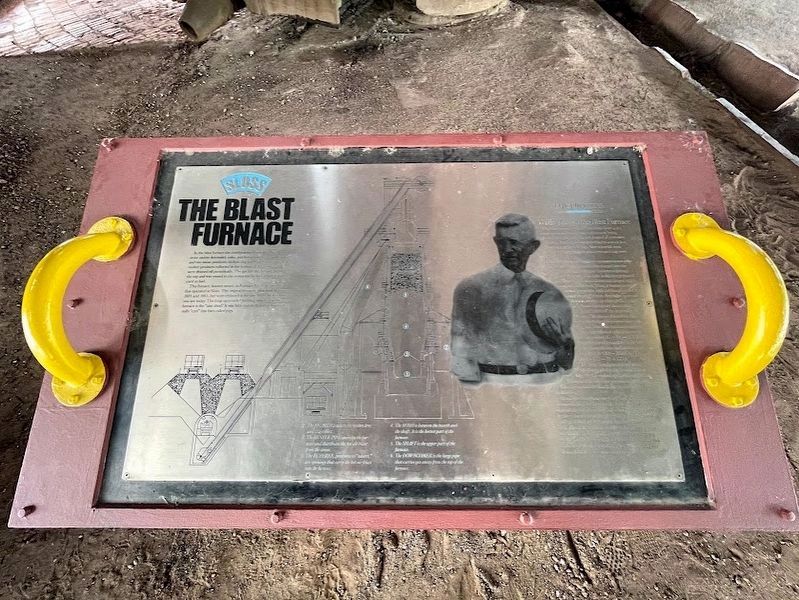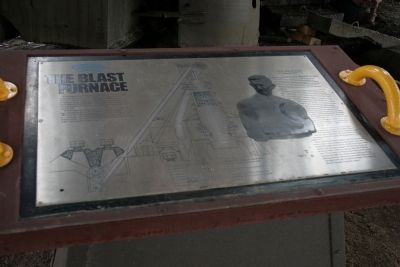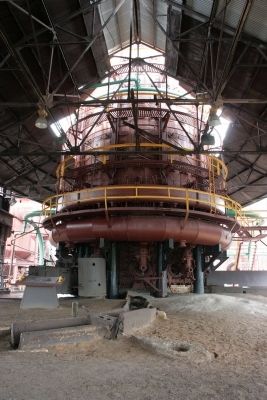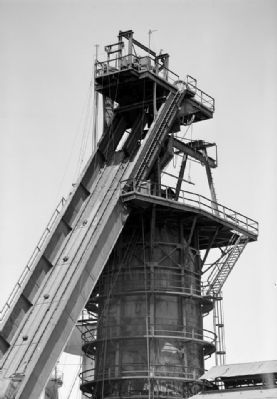Birmingham in Jefferson County, Alabama — The American South (East South Central)
The Blast Furnace
Sloss Furnaces National Historic Landmark
In the blast furnace the combination of iron ore, flux (limestone and/or dolomite), coke, and hot air produced molten iron and two waste products: molten slag and blast furnace gas. The molten products collected in the bottom of the furnace and were drained off periodically. The gas left the furnace through the top and was routed to the stoves and boilers where it was used as fuel.
This furnace, known simply as Furnace No. 1, is one of two that operated at Sloss. The original furnaces were built between 1881 and 1883, but were replaced in the late 1920s by the one you see today. The long open-side building attached to the furnace is the "cast shed." It was here that molten iron was originally "cast" into bars called pigs.
The Process
Making Iron in the Blast Furnace
The blast furnace worked twenty-four hours a day, seven days a week, so it was continuously being charged with raw materials and drained of it molten products. The furnace was kept filled to a stock line about six feet from the top. New material were added at the same rate at which iron and slag were produced.
The blast furnace operated on a countercurrent principle. Iron ore, flux, and coke were charged into the top, while hot air was blown into the bottom through openings called tuyeres. The coke in the charge passed down through the furnace almost unchanged until it reached the tuyeres. There it burned to form carbon monoxide, with the liberation of a large amount of heat. As the hot combustion gases swept up through the furnace, they heated the slowly descending stock and "reduced" the iron oxides in the ore. The chemical reactions that occurred during this process were quite complex. The basic reactions consisted of the combustion of coke to form carbon monoxide (2C + O2 - 2CO) and the reduction of iron oxides in the ore to yield metallic iron and carbon dioxide (Fe2O3 + CO - 2FeO + CO2; FeO + CO - Fe + CO2).
The freed iron formed drops which trickled into a pool at the hearth. Meanwhile, the flux soaked up the impurities from the ore and the ash from the coke to form slag. The slag ran into the hearth and floated on top of the molten iron.
About every four hours workers "cast" the furnace to remove the iron accumulated in the hearth. Iron was drained through the iron notch, a hole at the base of the furnace that was kept plugged with fireclay. A crew of workers drilled a hole through the clay, releasing the iron. The molten iron flowed down the curved runner and into the ladle car, which transported it to the pig casting machine. When the cast ended, the notch was replugged with clay using the mud gun. The slag was drained through a separate runner.
Erected by Sloss Furnaces Historic Landmark.
Topics. This historical marker is listed in this topic list: Industry & Commerce. A significant historical year for this entry is 1881.
Location. 33° 31.24′ N, 86° 47.447′ W. Marker is in Birmingham, Alabama, in Jefferson County. Marker can be reached from the intersection of 32nd Street North and 2nd Avenue North, on the left when traveling north. This marker is located on the grounds of the Sloss Furnaces National Historic Landmark. Touch for map. Marker is at or near this postal address: 20 32nd Street North, Birmingham AL 35222, United States of America. Touch for directions.
Other nearby markers. At least 8 other markers are within walking distance of this marker. Casting Pigs (a few steps from this marker); The Stock Trestle (a few steps from this marker); Stock Trestle/Tunnel (a few steps from this marker); Slag (a few steps from this marker); The Gas System (within shouting distance of this marker); Racial Terrorism and Convict Leasing / Racial Violence at Brookside Mines (within shouting distance of this marker); Ironmaking (within shouting distance of this marker); Boilers (within shouting distance of this marker). Touch for a list and map of all markers in Birmingham.
More about this marker. This marker can be found under Furnace Number 1's casting shed next to the furnace.
Also see . . .
1. Sloss Furnaces National Historic Landmark. (Submitted on October 7, 2013.)
2. Sloss-Sheffield Steel & Iron, First Avenue North Viaduct at Thirty-second Street, Birmingham... The Historical American Buildings Engineering Record for the Sloss-Sheffield steel and iron facility. 135 photos, 20 drawings, plus a lengthy history of the facility. (Submitted on October 8, 2013.)
Credits. This page was last revised on April 21, 2023. It was originally submitted on October 6, 2013, by Timothy Carr of Birmingham, Alabama. This page has been viewed 838 times since then and 25 times this year. Photos: 1. submitted on April 18, 2023, by Darren Jefferson Clay of Duluth, Georgia. 2, 3. submitted on October 6, 2013, by Timothy Carr of Birmingham, Alabama. 4. submitted on October 8, 2013. • Bernard Fisher was the editor who published this page.



